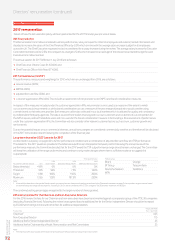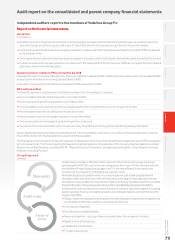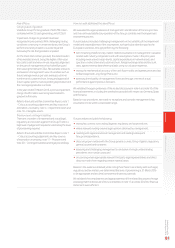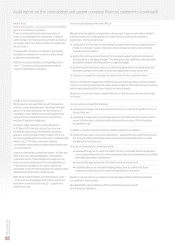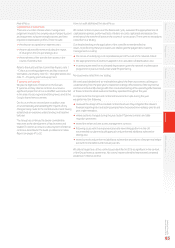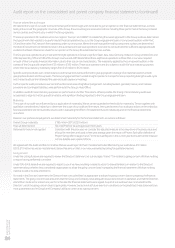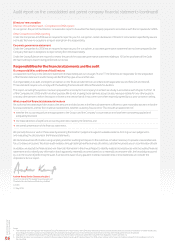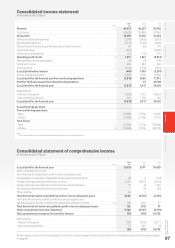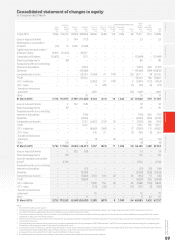Vodafone 2016 Annual Report Download - page 84
Download and view the complete annual report
Please find page 84 of the 2016 Vodafone annual report below. You can navigate through the pages in the report by either clicking on the pages listed below, or by using the keyword search tool below to find specific information within the annual report.
Vodafone Group Plc
Annual Report 2016
82
Audit report on the consolidated and parent company nancial statements (continued)
Area of focus How our audit addressed the area of focus
Revenue recognition – accuracy of revenue recorded
given the complexity of systems
There is an inherent risk around the accuracy of
revenue recorded given the complexity of systems
and the impact of changing pricing models to revenue
recognition (tariff structures, incentive arrangements,
discounts etc.).
The application of revenue recognition accounting
standards is complex and involves a number of key
judgements and estimates.
Refer to the Audit and Risk Committee Report and
note1 – Critical accounting judgements and key
sources of estimation uncertainty.
We instructed the eight local operations in Group audit scope to undertake consistent
audit procedures. Our audit approach included controls testing and substantive
procedures covering, in particular:
a testing the IT environment in which billing, rating and other relevant support systems
reside, including the change control procedures in place around systems that bill
material revenue streams;
a testing the end-to-end reconciliation from business support systems to billing and
rating systems to the general ledger. This testing included validating material journals
processed between the billing system and general ledger;
a performing tests on the accuracy of customer bill generation on a sample basis and
testing of a sample of the credits and discounts applied to customer bills; and
a testing cash receipts for a sample of customers back to the customer invoice.
We also considered the application of the Group’s accounting policies to amounts billed
and the accounting implications of new business models to check that Group accounting
policies were appropriate for these models and were followed.
Based on our work, we noted no signicant issues on the accuracy of revenue recorded
inthe year.
Signicant one-off transactions
We focused on two signicant one-off transactions
which occurred during the year: the receipt of Indian
spectrum auction allocations and the issuance of
mandatory convertible bonds. Accounting for these
transactions and related disclosures requires the
exercise of signicant judgement.
Receipt of Indian spectrum auction allocations –
at31 March 2015 the allocation of spectrum was
provisional subject to governmental and judiciary
approval. During the year ended 31 March 2016, the
Group recognised spectrum assets and a corresponding
liability of £2,731 million as the prior material
uncertainties surrounding the approval processes were
no longer present.
Issuance of mandatory convertible bonds – in February
2016 the Group issued £2.88 billion of mandatory
convertible bonds. There is signicant judgement on
the accounting classication of the convertible bond.
The bonds are classied as a compound nancial
instrument and £119 million has been recognised within
liabilities and £2,754 million within equity.
Refer to the Audit and Risk Committee Report, note1
– Critical accounting judgements and key sources of
estimation uncertainty and note 22 – Liquidity and
capital resources.
Our procedures included the following:
a evaluating the design and implementation of controls in respect of signicant one-off
transactions; and
a evaluating management’s accounting papers on how IFRSs have been applied to the
receipt of Indian spectrum auction allocations and the issuance of the mandatory
convertible bonds.
In addition we performed procedures on specic transactions as follows:
a receipt of Indian spectrum auction allocations – assessed the key judgements around
the timing of when substantially all of the risks and rewards of the spectrum asset
transferred to the Group; and
a issuance of mandatory convertible bonds –
a reviewed the key terms within the bond contract to conclude that the designation
as a compound nancial instrument was appropriate and no separately accountable
embedded derivatives were present;
a assessed the appropriateness of the liability and equity split; and
a considered the terms of related hedging transactions to conrm that these
transactions should be accounted for independently to the bond.
Based on our procedures, we noted no issues and were satised with the associated
accounting for these matters.
We validated the appropriateness of the related disclosures in note 22
of the nancial statements.


